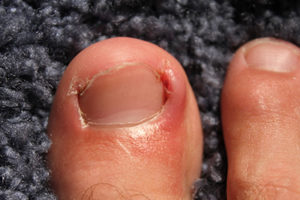Ingrown Toenail Surgery
Why Do Ingrown Toenails Happen?
 An ingrown toenail is essentially when the nail grows into the soft fleshy part of the nail bed, instead of straight up like it should. It is usually the result of poor grooming habits or wearing shoes that are too tight. When you trim your nails make sure you always do it straight across and not in a curved fashion of any kind. You can always go back and file them into your desired shape and length. Your footwear may also play a part. When your toes are crammed into tight, pointy shoes they have no wiggle room. They are almost trapped in one place and all that pressure can lead to nails growing the wrong way. Ingrown toenails can be painful; they can cause redness, irritation, swelling, and even infection if left untreated.
An ingrown toenail is essentially when the nail grows into the soft fleshy part of the nail bed, instead of straight up like it should. It is usually the result of poor grooming habits or wearing shoes that are too tight. When you trim your nails make sure you always do it straight across and not in a curved fashion of any kind. You can always go back and file them into your desired shape and length. Your footwear may also play a part. When your toes are crammed into tight, pointy shoes they have no wiggle room. They are almost trapped in one place and all that pressure can lead to nails growing the wrong way. Ingrown toenails can be painful; they can cause redness, irritation, swelling, and even infection if left untreated.
Conservative Treatment Options
Of course, we always prefer to treat your ingrown toenail conservatively and without the use of invasive means, but it isn’t always possible. However, here are some options to try before making the leap to surgery.
- Changing your footwear and avoiding anything that confines your toes while your toenail heals.
- Soaking your feet in warm water and then gently pushing the skin back with an olive oil soaked cotton ball.
- Cover your toenail with cotton or a bandage to relieve some of the pressure and pain.
- Apply antibiotic ointment to the affected toe.
Making the Decision to Undergo Surgery
If the conservative treatments did not help your ingrown toenail, or if it has become infected you may need to find out how surgery can be beneficial. The procedure to remove your toenail is fairly quick and simple. It is done on an outpatient basis under a local anesthetic. You will also need a tetanus shot if it has been more than 5 years because your risk of infection is very high with an open wound. If there is already an infection your doctor will drain it and then remove the portion of the toenail necessary for complete healing.
Sometimes you are just more likely to develop ingrown toenails than others. Recurring cases of infection can create a lot of frustration for you, so in very severe cases your doctor may make the decision to completely destroy the edge of the nail that is causing the problem. The most extreme version of this is to have the entire nail matrix destroyed. This means that your nail will never grow back. After your surgery your nail will be covered with antibacterial ointment and gauze. It is very important to follow all post-operative instructions, including how to keep the wound clean.
How Can We Help?
If you have a stubborn ingrown toenail that just won’t go away or has become infected you might consider having the nail surgically removed. Call Dr. Mitchell Wachtel at (978) 794-8406 to schedule an appointment in one of our three Massachusetts office locations.
